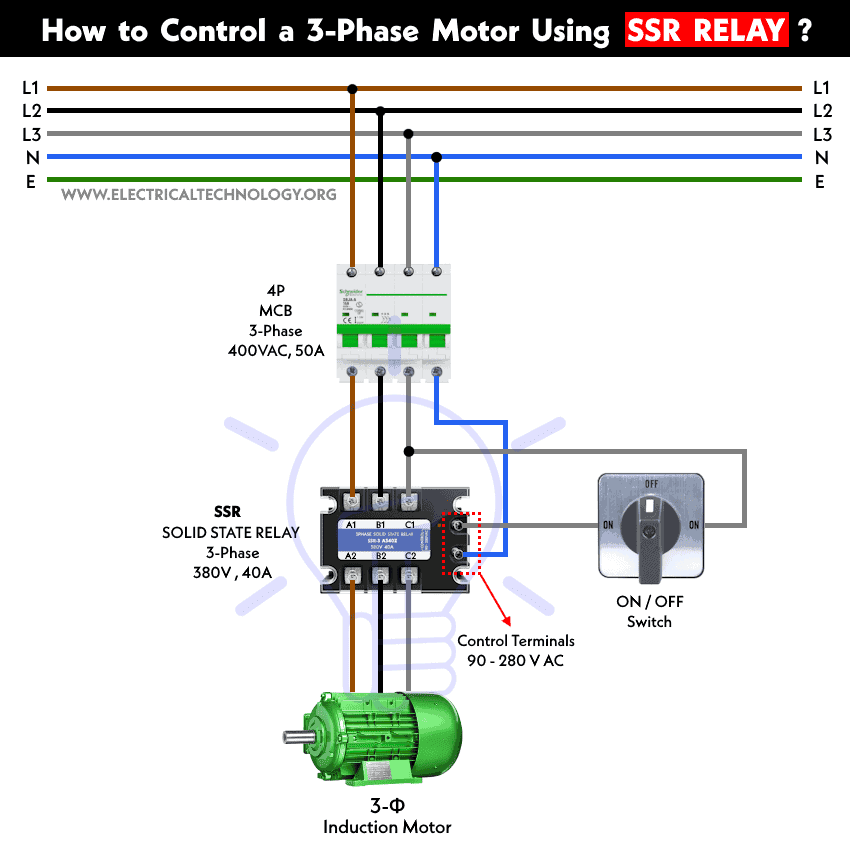How to Control a Three-Phase Motor Using Solid-State Relay?
Controlling a Three-Phase Motor using Solid-State (SSR) Relay
Controlling three-phase motors is a common requirement in industrial applications. Traditionally, electromechanical and other types of relays have been used for motor control, but solid-state relays (SSRs) offer a reliable and efficient control over traditional electromechanical relays. SSRs provide fast switching capabilities and precise control over the motor’s operation. In the following article, we will explain the concept of controlling a three-phase motor using an SSR relay with step-by-step guide for its implementation using the power and control circuit diagrams.
SSR Relays
Solid-state relays (SSR) are electronic switching devices that use semiconductor technology to control the flow of current. Unlike electromechanical relays, SSRs have no moving parts, resulting in silent operation, increased lifespan, and improved reliability. SSRs consist of an input control circuit, which typically accepts a low-voltage signal, and an output power circuit that can handle high-voltage and high-current applications. They provide rapid switching by using solid-state components such as Thyristors or TRIAC.
Components Needed
- 3-Phase Motor
- MCB – 4P, 400V, 50-63A
- SSR Relay
- ON / OFF Selector Switch
- Indicators and Pilot Lights
- 230V Single Phase AC Supply
- 400V – Three Phase AC Supply
- Wires and Cables
Wiring & Control Diagram
The following wiring, power and control diagram illustrates how to control a 400-415V three-phase motor using solid-state relay (SSR).
Click image to enlarge
Controlling a 3-Phase Motor using SSR Relay
Step 1: Selection of SSR Relay: Select an appropriate SSR relay suitable for controlling a three-phase motor. Consider the voltage and current ratings of the motor and ensure that the SSR relay can handle the required power levels.
Step 2: Wiring Connections: Identify the motor’s three-phase power lines (L1, L2, L3) and the corresponding connections on the SSR relay (A1, B1 and C1). Connect the motor’s three-phase power lines to the output terminals of the SSR relay (A2, B2 and C2), ensuring correct polarity and phase sequence. Follow the manufacturer’s wiring diagram and guidelines for proper connections.
Step 3: Control Circuit Connection: The control circuit of the SSR relay requires a low-voltage signal (90V to 230V AC) to activate the switching operation. Connect the control signal source, such as a programmable logic controller (PLC), sensor, ON/OFF switch or a control panel, to the input terminals of the SSR relay. For example, we have used the ON/OFF selector switch to the single phase and upper terminal of control circuit and neutral wire to the lower terminal of control circuit rated for 90-280V AC.
Step 4: Protective Measures: To protect the motor and SSR relay from any potential issues, consider incorporating additional protective measures. These may include thermal overload protection, phase loss detection, and short circuit protection via MCB and MCCB or RCD.
Step 5: Testing and Calibration: Once the wiring connections are complete, conduct thorough testing and calibration to ensure the proper functioning of the motor control system. Verify that the control signals activate the SSR relay correctly and that the motor responds accordingly. Monitor the system during operation and check for any abnormalities or unexpected behavior.
Step 7: Monitoring and Maintenance: Regularly monitor the performance of the motor control system and conduct preventive maintenance to ensure optimal operation. Inspect the SSR relay for any signs of overheating or damage and replace any faulty components promptly. Keep the system clean and free from dust or debris that could affect its performance.
Safety Precautions
Before working on any electrical connections, ensure proper safety precautions.
- Disconnect the power supply to the motor and follow safety guidelines, including wearing appropriate personal protective equipment (PPE).
- Refer to the manufacturer’s specifications and guidelines for selecting the right SSR relay, MCB and rating of Motor.
- Consult the manufacturer’s guidelines, licensed electrician or an electrical engineer to determine the appropriate protective measures based on your specific application.
Summary
Controlling a three-phase motor using an SSR relay offers numerous advantages, including fast switching, improved reliability, and reduced wear and tear. By following the step-by-step guide outlined in this article, you can successfully implement an SSR relay for precise and efficient control of three-phase motors. Remember to adhere to safety guidelines and consult the manufacturer’s specifications and guidelines for the specific SSR relay model being used.
Related Posts
- How to Start & Stop a 3-Phase Motor Using Direct-On-Line (DOL) Starter?
- Wiring of DOL Starter for Automatic / Manual Control Using Digital Timer
- How to Control a 3-Phase Motor Using a Foot Pedal Switch?
- How to Control a 3-Phase Motor Using a Motor Protector?
- How to Control the Compressor Motor in Refrigeration Using Soft Starter?
- Automatic & Manual Control of 3-Phase Motor Using Delay Timer
- Auto & Manual Control of 3-Phase Water Pump Motor using Float Switch
- Auto & Manual Control of 1-Phase Water Pump Motor using Float Switch







